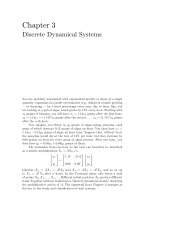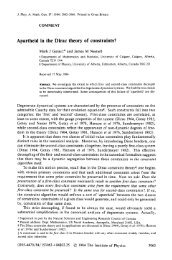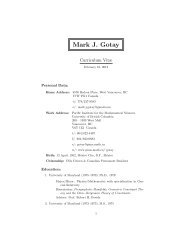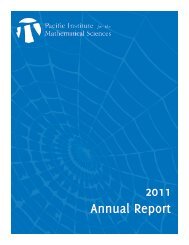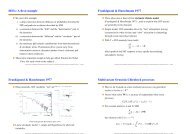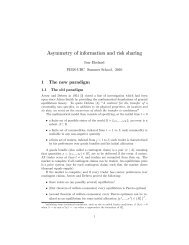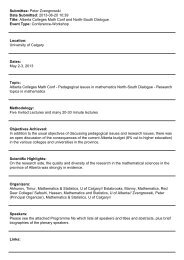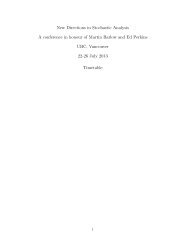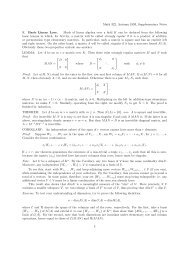5 PRIMA 2013 AbstractsprocessesXu SunHuazhong University of Science and Technology, Chinaxsun15@gmail.com; xsun@hust.edu.cnThe Fokker-Planck equ<strong>at</strong>ions describe time evolution ofprobability densities of stochastic dynamical systems andare thus widely used to quantify random phenomenasuch as uncertainty propag<strong>at</strong>ion. For dynamical systemsdriven by non-Gaussian Lévy processes, however, it is difficultto obtain explicit forms of Fokker-Planck equ<strong>at</strong>ions.In the present paper, Fokker-Planck equ<strong>at</strong>ions are derivedfor nonlinear stochastic differential equ<strong>at</strong>ions withnon-Gaussian Lévy processes. The stochastic differentialequ<strong>at</strong>ions are considered in sense of both Ito and Marcus.A few examples are presented to illustr<strong>at</strong>e the method.P<strong>at</strong>h-dependent optimal stochastic controland viscosity solution of associ<strong>at</strong>ed Bellmanequ<strong>at</strong>ionsShanjian Tang & Fu ZhangFudan University, Chinasjtang@fudan.edu.cnAbstract In this paper we study the optimal stochasticcontrol problem for a p<strong>at</strong>h-dependent stochastic systemunder a recursive p<strong>at</strong>h-dependent cost functional, whoseassoci<strong>at</strong>ed Bellman equ<strong>at</strong>ion from dynamic programmingprinciple is a p<strong>at</strong>h-dependent fully nonlinear partial differentialequ<strong>at</strong>ion of second order. A novel notion of viscositysolutions is introduced by restricting the semi-jetson an α -Hölder space C α for α ∈ (0, 1 ). Using Dupire’s2functional Itô calculus, we prove th<strong>at</strong> the value functionalof the optimal stochastic control problem is a viscositysolution to the associ<strong>at</strong>ed p<strong>at</strong>h-dependent Bellman equ<strong>at</strong>ion.We expect th<strong>at</strong> our viscosity solution is the valuefunctional in a fairly general situ<strong>at</strong>ion.Self-similarity for some SPDEsWei WangNanjing University, Chinawangweinju@yahoo.com.cnThis talk discusses self-similarity in distribution, whichis called stochastic self-similarity, for some SPDEs. Twotypes of noise are considered, one is additive noise and theother is of some multiplic<strong>at</strong>ive noise. The existence of aself-similar solution is implied by the existence of a st<strong>at</strong>ionarysolution under self-similar variables. We furthershow the <strong>at</strong>tracting property of a self-similar solution.For the case additive noise, different <strong>at</strong>traction is consideredby different approach. For the case of multiplic<strong>at</strong>ivenoise, a diffusion approxim<strong>at</strong>ion approach is applied.The availability of logical oper<strong>at</strong>ion inducedby dichotomous noise for a nonlinear bistablesystemYong Xu, Xiaoqin Jin, Huiqing Zhang & Tingting YangNorthwestern Polytechnical University, Chinahsux3@nwpu.edu.cnąąInstead of a continuous system driven by Gaussian whitenoise, logical stochastic resonance will be investig<strong>at</strong>ed ina nonlinear bistable system with two thresholds drivenby dichotomous noise, which shows a phenomenon differentfrom Gaussian white noise. We can realize twoparallel logical oper<strong>at</strong>ions by simply adjusting the valuesof these two thresholds. Besides, to quantify the reliabilityof obtaining the correct logic output, we numericallycalcul<strong>at</strong>e the success probability, and effects of dichotomousnoise on the success probability are observed, theseobserv<strong>at</strong>ions show th<strong>at</strong> the reliability of realizing logicaloper<strong>at</strong>ion in the bistable system can be improved throughoptimizing parameters of dichotomous noise.Backward stochastic partial differential equ<strong>at</strong>ionsand their applic<strong>at</strong>ion to stochasticBlack-Scholes formulaQi ZhangFudan University, Chinaqzh@fudan.edu.cnThe backward SPDEs, origin<strong>at</strong>ed from the study of optimalcontrol theory of SPDEs, can be applied to m<strong>at</strong>hem<strong>at</strong>icalfinance problems. We demonstr<strong>at</strong>e their applic<strong>at</strong>ionto stochastic Black-Scholes formula, in a generalsetting to the parameters of the model. This applic<strong>at</strong>ionis based on our recent studies of the solvability to degener<strong>at</strong>ebackward SPDEs without technical assumptions andtheir connection to forward-backward SDEs. The connectionbetween backward SPDEs and forward-backwardSDEs can also be regarded as an extension of Feynman-Kac formula to non-Markovian framework.Malliavin m<strong>at</strong>rix of degener<strong>at</strong>e PDE and gradientestim<strong>at</strong>esDong ZhaoAcademy of M<strong>at</strong>hem<strong>at</strong>ics and Systems Science, CAS,Chinadzhao@amt.ac.cnIn this talk, we present the bounded of the inverse forMalliavin M<strong>at</strong>rix of Degener<strong>at</strong>e PDE under a new condition,which is equivalent to the Hoermander condition asthe coefficients are smooth. Also, the gradient estim<strong>at</strong><strong>at</strong>sfor the semigroup is given.Special Session 2Algebraic and Complex GeometryPluricanonical maps and minimal models ofthreefoldsJunkai ChenN<strong>at</strong>ional Taiwan University, Taiwanjkchen@ntu.edu.twGiven a smooth projective variety, there are n<strong>at</strong>ural mapsinduced by the pluricanonical system. It is n<strong>at</strong>ural to askwhen the pluricanonical maps stablized bir<strong>at</strong>ionally. Onthe other hand, it is known th<strong>at</strong> there exists a minimalmodel with terminal singularities. This model play thekey ingredient in the study of geometry of threefolds. Inthis talk, we are going to demonstr<strong>at</strong>e some applic<strong>at</strong>ionof bir<strong>at</strong>ional geometry th<strong>at</strong> one can obtain by comparingabove two structures.Some bir<strong>at</strong>ionality criteria on 3-folds withp g > 1Meng ChenFudan University, Chinamchen@fudan.edu.cnWe give some bir<strong>at</strong>ionality criteria for ϕ m (m = 4, 5, 6,7) on general type 3-folds with p g ≥ 2 by means of anintensive classific<strong>at</strong>ion.Division algebras of transcendence degree twoColin IngallsUniversity of New Brunswick, Canadacingalls@unb.caWe study Artin’s conjecture th<strong>at</strong> division algebras of fractionsof domains of dimension two are either r<strong>at</strong>ional,
6 PRIMA 2013 Abstractsruled or finite over their centres. We have a proof of theconjecture th<strong>at</strong> depends adds a few other conditions. Weshow th<strong>at</strong> such domains over finite fields are finite overtheir centres. Then a deform<strong>at</strong>ion theory argument fororders over surfaces shows th<strong>at</strong> we have Artin’s conjecturedclassific<strong>at</strong>ion. This is work in progress with JasonBell.Geometry and syzygies in the first linearstrandSijong KwakKorea Advanced Institute of Science and Technology, Koreasjkwak@kaist.ac.krProperty N d,p , d ≥ 2 for algebraic sets is defined (dueto Eisenbud-Green-Hulek-Popescu) as follows: the j-thsyzygies of the homogeneous coordin<strong>at</strong>e ring are gener<strong>at</strong>edby elements of degree ≤ d−1+j for 1 ≤ j ≤ p. Whend = 2, linear syzygies of quadr<strong>at</strong>ic schemes have been focusedfor a long time. In this talk, we consider upperbounds and lower bounds of higher linear syzygies in thefirst linear strand of Betti tables for projective varietiesin arbitrary characteristic. For this purpose, we establishfundamental inequalities which govern the rel<strong>at</strong>ionsbetween the graded Betti numbers of an algebraic set Xand those of its inner projection X q in the first linearstrand. We obtain some n<strong>at</strong>ural sharp upper bounds andlower bounds for linear syzygies of any non-degener<strong>at</strong>eprojective variety using these inequalities. We also classifywh<strong>at</strong> the extremal case and next-to-extremal caseare. From the viewpoint of ’syzygies’, this is a generaliz<strong>at</strong>ionof Castelnuovo and Fano’s results on the numberof quadrics containing a given variety.C<strong>at</strong>egorific<strong>at</strong>ion of Donaldson-Thomas invariantsand Gopakumar-Vafa invariantsJun LiStanford University, USAjli@m<strong>at</strong>h.stanford.eduFor a projective Calabi-Yau threefold, we can form themoduli of stable sheaves with prescribed Chern classes.The Donaldson-Thomas invariants of this Calabi-Yauthreefolds are virtual degrees of these moduli spaces.In this talk, we will show th<strong>at</strong> each of such modulispaces admits perverse sheaves whose Euler classes arethe Donaldson-Thomas invariants associ<strong>at</strong>ed to the modulispaces. Using such sheaves, we propose a new definitionof Gopakumar-Vafa invariants of Calabi-Yau threefolds.This is a joint work with Young-Hoon Kiem.CompactsAmnon NeemanThe Australian N<strong>at</strong>ional University, AustraliaAmnon.Neeman@anu.edu.auFor a fl<strong>at</strong> map f : X −→ Y of noetherian schemes onemay define functors Lf ∗ , Rf ∗, f × and f ! on appropri<strong>at</strong>ederived c<strong>at</strong>egories of quasicoherent sheaves. In two recentpapers, one by Avramov and Iyengar and the secondby Avramov, Iyengar, Lipman and Nayak, the authorsproved some remarkable formulas rel<strong>at</strong>ing f ! , f × and certainHochschild homology objects. I will discuss a newapproach to the results in terms of a map ψ : f × −→ f ! .Smooth quartic K3 surfaces and Cremon<strong>at</strong>ransform<strong>at</strong>ionsKeiji OguisoOsaka University, Japan and Korea Institute for AdvancedStudy, Koreaoguiso@m<strong>at</strong>h.sci.osaka-u.ac.jpWe discuss about the following question of Giz<strong>at</strong>ullin:Question. Is an automorphism g of a smooth quarticK3 surface S ⊂ P 3 derived from some bir<strong>at</strong>ional automorphism,i.e., some Cremona transform<strong>at</strong>ion of the ambientspace P 3 ? More precisely, first I explain the followingneg<strong>at</strong>ive result: Theorem 1. There is a smooth K3 surfaceS of Picard number 2 such th<strong>at</strong> (i) Aut (S) ≃ Z and(ii) No element Aut (S) other than id S is derived fromBir (P 3 ) in any embedding of S into P 3 . Then, I explainthe following positive result: Theorem 2. Thereis a smooth K3 surface S of Picard number 2 such th<strong>at</strong>(i) Aut (S) ≃ Z and (ii) Aut (S) is derived from Bir (P 3 )in any embedding of S into P 3 . As I will explain inmy talk, examples in Theorem 2 are the ones found in acompletely different context. However, they turn out tobe very closely rel<strong>at</strong>ed with old works of Cayley, Snyderand Sharpe, as it is discovered by Festi, Garbagn<strong>at</strong>i, vanGeemen and vam Luijk quite recently. Being based onall of their works, I describe the automorphism group ofthese S both explicitly algebraically in terms of homogeneouscoordin<strong>at</strong>es and explicitly geometrically in terms ofSarkisov link.The Hilbert scheme of points and extensionsof local fieldsTakehiko YasudaOsaka University, Japantakehikoyasuda@m<strong>at</strong>h.sci.osaka-u.ac.jpTwo formulas very similar to each other appear in totallydifferent contexts, the Hilbert scheme of points and Bhargava’sformula for extensions of local fields. In this talk,I will explain the similarity as a special case of the wildMcKay correspondence. The talk is based on a joint workwith Melanie M<strong>at</strong>chett Wood.Positivity of log canonical divisors andMori/Brody hyperbolicityDe-Qi ZhangN<strong>at</strong>ional University of Singapore, Singaporem<strong>at</strong>zdq@nus.edu.sgLet X be a complex projective variety of dimension n andD a reduced divisor with a decomposition D = ∑ ri=1 D i,where the D i ’s are reduced Cartier but not necessarilyirreducible. The pair (X, D) is called Brody hyperbolic,respectively Mori hyperbolic, with respect to the decompositionif neither X\D nor (∩ i∈I D i )\(∪ j∈J D j ) containsa non-constant holomorphic image, respectively algebraicimage, of C for every partition of {1, . . . , r} = I ∐ J.Assuming th<strong>at</strong> the singularities of the pair (X, D) aresufficiently mild, we show th<strong>at</strong> the log canonical divisorK X +D is numerically effective in the case of Mori hyperbolicityand th<strong>at</strong> K X + D is ample provided th<strong>at</strong> eithern < 4 and D is non-empty or <strong>at</strong> least n−2 of the D i ’s areample in the case of Brody hyperbolicity. Our proof alsogives simple geometric criteria for the log canonical divisorK X + D to be numerically effective or to be ample inthe above (respective) cases and, under weaker geometricconditions, for K X + D to be pseudo-effective. This is ajoint work with Steven Lu.Special Session 3Algebraic Topology and Rel<strong>at</strong>ed TopicsHomotopy colimits and commut<strong>at</strong>ive elementsin Lie groupsAlejandro AdemUniversity of British Columbia, Canadaadem@pims.m<strong>at</strong>h.ca
- Page 2 and 3: 1PRIMA 2013-Table of ContentsTable
- Page 4 and 5: 3PRIMA 2013-OrganizationOrganizatio
- Page 6 and 7: 5PRIMA 2013-OrganizationYoshikazu G
- Page 8 and 9: 7PRIMA 2013-Useful InformationUsefu
- Page 10 and 11: 9PRIMA 2013-Useful InformationTaxi:
- Page 12 and 13: 11PRIMA 2013-Useful Informationmath
- Page 14 and 15: 13PRIMA 2013 Program-Schedule-at-a-
- Page 16 and 17: 15PRIMA 2013 Program-Monday, June 2
- Page 18 and 19: 17PRIMA 2013 Program-Monday, June 2
- Page 20 and 21: 19PRIMA 2013 Program-Monday, June 2
- Page 22 and 23: 21PRIMA 2013 Program-Monday, June 2
- Page 24 and 25: 23PRIMA 2013 Program-Tuesday, June
- Page 26 and 27: 25PRIMA 2013 Program-Tuesday, June
- Page 29 and 30: 28PRIMA 2013 Program-Tuesday, June
- Page 31 and 32: 30PRIMA 2013 Program-Tuesday, June
- Page 33 and 34: 32PRIMA 2013 Program-Wednesday, Jun
- Page 35 and 36: 34PRIMA 2013 Program- Thursday, Jun
- Page 37 and 38: 36PRIMA 2013 Program- Thursday, Jun
- Page 39 and 40: 38PRIMA 2013 Program- Thursday, Jun
- Page 41 and 42: 40PRIMA 2013 Program- Thursday, Jun
- Page 43 and 44: 42PRIMA 2013 Program- Friday, June
- Page 45 and 46: 44PRIMA 2013 Program- Friday, June
- Page 48 and 49: 1 PRIMA 2013 AbstractsContents1 Pub
- Page 50 and 51: 3 PRIMA 2013 Abstractsof subfactors
- Page 54 and 55: 7 PRIMA 2013 AbstractsIn this talk
- Page 56 and 57: 9 PRIMA 2013 Abstractsindependently
- Page 58 and 59: 11 PRIMA 2013 AbstractsEnumerating,
- Page 60 and 61: 13 PRIMA 2013 AbstractsRyuhei Uehar
- Page 62 and 63: 15 PRIMA 2013 AbstractsIn this talk
- Page 64 and 65: 17 PRIMA 2013 AbstractsSpecial Sess
- Page 66 and 67: 19 PRIMA 2013 Abstractscritical slo
- Page 68 and 69: 21 PRIMA 2013 AbstractsSpecial Sess
- Page 70 and 71: 23 PRIMA 2013 Abstractsstrictly awa
- Page 72 and 73: 25 PRIMA 2013 AbstractsPedram Hekma
- Page 74 and 75: 27 PRIMA 2013 Abstractsis well-know
- Page 76 and 77: 29 PRIMA 2013 Abstractssolid substr
- Page 78 and 79: 31 PRIMA 2013 AbstractsRapoport-Zin
- Page 80 and 81: 33 PRIMA 2013 Abstractssense. Our a
- Page 82 and 83: 35 PRIMA 2013 AbstractsIn an econom
- Page 84 and 85: 37 PRIMA 2013 AbstractsKyoto Univer
- Page 86 and 87: 39 PRIMA 2013 AbstractsAlexander Mo
- Page 88 and 89: 41 PRIMA 2013 AbstractsOsamu SaekiK
- Page 90 and 91: 43 PRIMA 2013 Abstractsopen Delzant
- Page 92 and 93: 45 PRIMA 2013 AbstractsJian ZhouTsi
- Page 94 and 95: 47 PRIMA 2013 AbstractsJiaqun WeiNa
- Page 96 and 97: 49 PRIMA 2013 Abstractsthe end of 2
- Page 98 and 99: 51 PRIMA 2013 AbstractsJongyook Par
- Page 100 and 101: 53 PRIMA 2013 AbstractsPancyclicity
- Page 102 and 103:
55 PRIMA 2013 AbstractsEfficient nu
- Page 104 and 105:
57 PRIMA 2013 Abstractsand fountain
- Page 106:
59 PRIMA 2013 Abstractsformula esti



